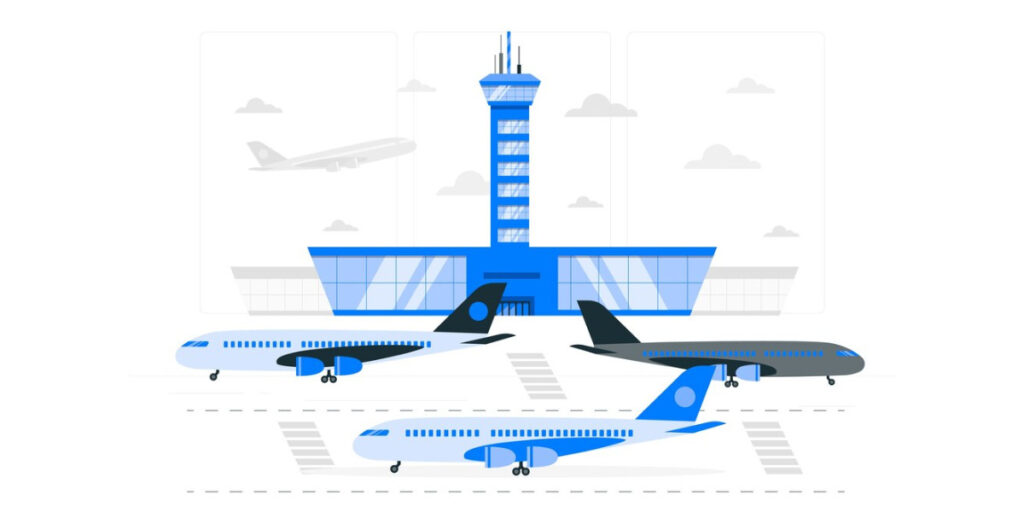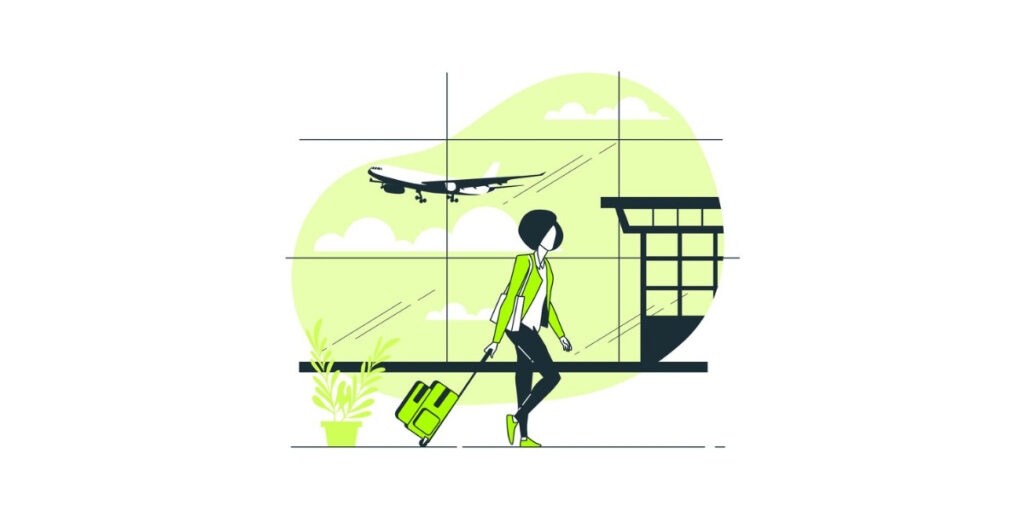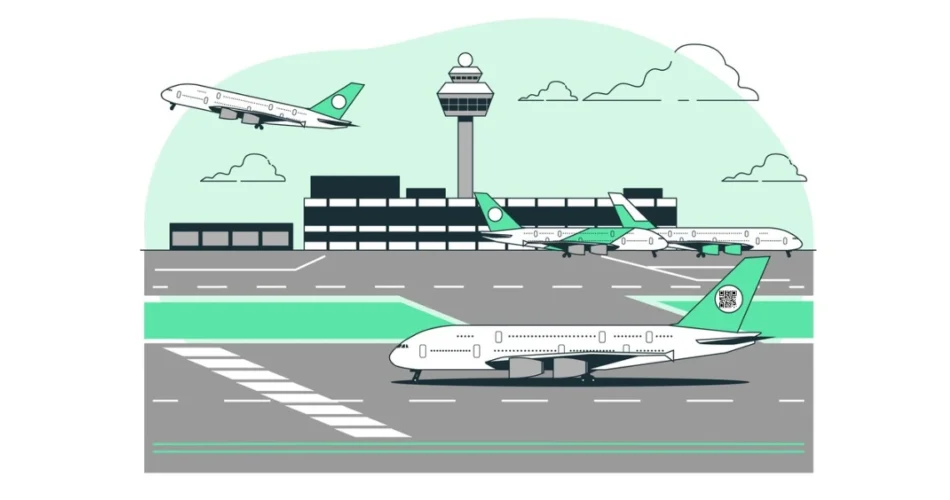Let’s face it: jet lag can make airports feel chaotic.
Even experienced travelers can complain about long queues, lost boarding cards, and stumbling through kiosks.
But what if all you took to get around an airport was to scan a QR Code?
Yes, it is. Airports everywhere are adopting these pixel-rich powerhouses to make travel easier, quicker, and—dare we say it—fun.
Airports are becoming tech-savvy travel centers thanks to QR Codes, which offer rapid boarding, luggage tracking, and eating options.
Why are these tiny squares having such a significant effect? Fasten your seatbelts, for the future of air travel is here and replete with airport QR Codes.
A. Quick guide: Airport QR Codes

Airport QR Codes are scannable two-dimensional barcodes used in airports to streamline operations and enhance passenger convenience.
These codes store data such as boarding information, baggage details, interactive maps, or payment links, which passengers or airport staff can access by scanning with a smartphone or scanner.
They eliminate the need for physical documents, improve operational efficiency, and enable a contactless, hassle-free travel experience.
B. How QR Codes enhance the passenger experience

Airport navigation is becoming easier thanks to QR Codes. They facilitate travel, save time, and lessen stress. Here’s how they assist, supported by examples from actual life:
1. Fast Check-ins
The days of standing in long lines are over. E-tickets with QR Codes allow travelers to check in quickly. You can use them at kiosks or counters for a quick, contactless process.
Example: Delta Airlines uses QR Codes at kiosks. Passengers can check in, print bag tags, and go straight to security.
2. No Paper Boarding Passes
Lose the paper! QR Code passes stay on your phone. Scan them at security and gates. No more searching through your bag.
Example: Singapore Airlines uses QR Code passes. You can check in and board with just your phone.
3. Flight Updates in Real-Time
Missed a gate change? Not anymore. Scan a QR Code to get flight updates sent to your phone.
Example: Heathrow Airport lets you scan codes on signs to get live flight info.
4. Track Your Bags
Wondering where your luggage is? QR Code tags let you track it at every step.
Example: Lufthansa adds QR Codes to baggage tags. Scan them to see where your bags are in real-time.
5. Find Your Way
Airports can be confusing. QR Codes on signs or maps give you step-by-step directions to your gate or favorite coffee shop.
Example: Hong Kong Airport has QR Codes on maps. They guide you to where you need to go.
6. Smarter Duty-Free Shopping
Don’t shop in a hurry. QR Codes let you browse products, check prices, and pre-order items. Some codes even offer discounts.
Example: Dubai Duty-Free uses QR Codes to show deals. You can also reserve items for pick-up.
7. Quick Access to Amenities
Need food or a spa visit? QR Codes near restaurants and lounges let you view menus, book spots, or order ahead.
Example: Changi Airport uses QR Codes for food and lounges. One scan gives you all the details.
8. Safe and Contactless Travel
QR Codes make post-pandemic travel safer. Use them for vaccine checks or health forms.
Example: Sydney Airport uses QR Codes to upload vaccine records and health info. It keeps lines moving and limits contact.
What our customers say about us:
C. Real-life cases: QR Codes in airports

Globally, airport experiences are being enhanced by QR Codes. Here are some actual instances of how they are simplifying flight travel:
1. Heathrow Airport: Flight Updates
Heathrow in London uses QR Codes on flight displays. Travelers can use their phones to scan the codes and receive real-time flight information, such as gate changes or delays.
2. Delta Airlines: Fast Check-Ins
At its check-in kiosks, Delta Airlines employs QR Codes. To avoid long lineups, travelers scan their e-ticket code to check in, print bag tags, and proceed swiftly to security.
3. Singapore Airlines: Digital Boarding Passes
Singapore Airlines sends QR Code boarding passes to passengers via their mobile app. Travelers scan them at security and boarding gates, skipping paper tickets.
4. Hong Kong Airport: Easy Navigation
QR Codes are used on signs and maps at Hong Kong International Airport. Passengers can get detailed instructions to gates, lounges, or dining establishments by scanning a code.
5. Lufthansa: Baggage Tracking
QR Codes are attached to baggage tags by Lufthansa. It is easy for travelers to know where their luggage is because they can scan the codes to track it in real-time.
6. Dubai Duty-Free: Shopping Deals
Dubai Duty-Free offers pre-order items and savings via QR Codes. Before boarding, passengers can pick up their orders and get exclusive offers by scanning the code.
7. Sydney Airport: Health Checks
Sydney Airport uses QR Codes for health checks and vaccine records. Passengers scan the codes to upload documents, making the process smooth and contactless.
8. Changi Airport: Quick Service Access
Singapore’s Changi Airport posts QR Codes next to lounges, eateries, and amenities. Travelers can see menus, schedule services, or make reservations by scanning their phones’ codes.
9. Amsterdam Schiphol: Passenger Feedback
Amsterdam Schiphol Airport uses QR Codes to gather feedback from passengers. Travelers can easily express their opinions because the codes are posted in gates and waiting areas.
Hamburg Airport is the second-oldest commercial airport in operation, opening in 1911. 13 million travelers fly from Hamburg Airport to over 60 destinations on 115 international and domestic carriers yearly. Source: unacademy
D. Overcoming challenges in airport QR Code adoption

QR Codes enhance the airport experience; however, certain obstacles to their widespread use exist. To maximize this technology, airports are addressing these challenges as follows:
1. Outdated Technology Infrastructure
Many airports still rely on older systems that don’t easily integrate with QR technology. This makes it challenging to roll out QR Codes across the entire airport.
Solution: Leading airports like Changi and Heathrow are upgrading their technology infrastructure. They’re investing in modern systems seamlessly integrating QR Codes, making the transition smooth and efficient.
2. Security Concerns
Because they fear malware or phishing, travelers are reluctant to scan QR Codes. One of the biggest worries is that harmful software may target personal data.
Solution: Airports are addressing this by ensuring all QR Codes are securely generated and authenticated. Only trusted sources, such as airport authorities or airline systems, provide the codes to protect passenger data.
3. Digital Literacy
Not every traveler is tech-savvy, particularly elderly tourists who may find it challenging to utilize cell phones or QR Codes. This may hamper adoption.
Solution: Airports offer assistance by placing staff at key locations to help passengers with QR Code-related processes. Like those at Changi, clear, easy-to-follow signage and guides also support users unfamiliar with the technology.
4. Smartphone and Connectivity Limitations
Not everyone has access to cellphones with the internet, which is necessary for QR Codes to function. While traveling, some people might not have a smartphone or dependable connectivity.
Solution: To address this, airports provide free Wi-Fi, ensuring everyone can access QR Code services. Some airports are looking into alternatives, such as printing QR Codes for onboarding permits or ticket receipts for people without cell phones.
5. System Reliability and Maintenance
QR Code systems must be regularly maintained to avoid malfunctions that could disrupt travel. System failures can cause delays and frustrations for passengers.
Solution: Airports are working closely with tech partners to ensure their QR Code systems are robust, reliable, and regularly updated. They also have backup systems to minimize disruption in case of issues.
6. Passenger Resistance to Change
Some passengers prefer traditional methods, such as paper tickets or manual check-ins, and are hesitant to embrace QR Codes.
Solution: Airports are gradually introducing QR Codes, allowing passengers to use either traditional methods or QR Codes. Over time, as more travelers experience the convenience, they’re more likely to adopt the new system.
In 2013, the Dabba-Yardeng Airport opened in China’s Sichuan province, reaching over 4400 meters, making it the highest airport in the world. Source: horizn
E. Future of QR Codes in airport operations

QR Codes are already changing airport operations and their role is set to grow. As technology improves, here’s how QR Codes will shape travel in the future:
1. Faster, Contactless Check-Ins
Check-ins will be even quicker with QR Codes. Soon, travelers can check in, drop off their bags, and navigate the airport more swiftly by scanning QR Codes.
What’s Next? Anticipate self-serving kiosks that will check your information, assign your seat, print your boarding pass, and scan QR Codes.
2. Simpler Security
Security checks will get faster with QR Codes. Passengers will scan their code linked to flight details instead of showing paper documents.
What’s Next? In the future, QR Codes paired with facial recognition will let you pass through security without showing ID or a boarding pass.
3. Personalized Travel
A more customized travel experience will be possible with QR Codes. Imagine traveling to the airport, scanning a code, and receiving personalized restaurant recommendations, gate directions, and check-in information.
What’s Next? Airports will track your preferences using apps and QR Codes to provide personalized information and recommendations.
4. Better Baggage Tracking
Tracking your stuff will be more straightforward with QR Codes. You can receive real-time location updates by scanning the QR Code on your backpack.
What’s Next? When your luggage is loaded or prepared for collection at baggage claim, smart luggage equipped with QR Codes will notify you.
5. Easy, Contactless Payments
Airport buying will be easier with QR Codes. They can make fast, safe payments at restaurants, duty-free stores, and other retail locations.
What’s Next? Anticipate contactless purchasing, in which you can purchase an item, pay with your phone, and scan a QR Code without speaking to a cashier.
6. Easy Navigation
You can navigate airports more easily with the use of QR Codes. You can scan codes at various locations to get directions to meals, lounges, or gates.
What’s Next? With augmented reality, QR Codes might provide detailed instructions on your phone or through AR glasses.
7. Health and Safety Checks
QR Codes will continue to help with health checks. To enter different countries, you can scan codes to confirm your health status, including vaccination or COVID-19 testing.
What’s Next? QR Codes will link to health apps so you can store all your health documents in one place for easy access.
8. Paperless and Sustainable
Using QR Codes will help cut down on paper usage. There will be less need for paper since boarding tickets, flight information, and luggage tracking will all be accessible digitally.
What’s Next? QR Codes will be crucial in cutting waste and assisting airports in achieving sustainability objectives as more and more go paperless.
Brands that trust us:
Summing up
That concludes our discussion on how QR Codes change the airport travel experience! These tiny squares significantly contribute to your travels, from quicker check-ins to easy payments.
As more airports join the QR Code trend, you may anticipate even greater convenience on your next trip.
You might be shocked to learn how much QR Codes are doing in the background to get you where you need to go more quickly and efficiently than ever before, so have a peek around the next time you’re flying.
Remember to scan that code, and have a safe trip!
